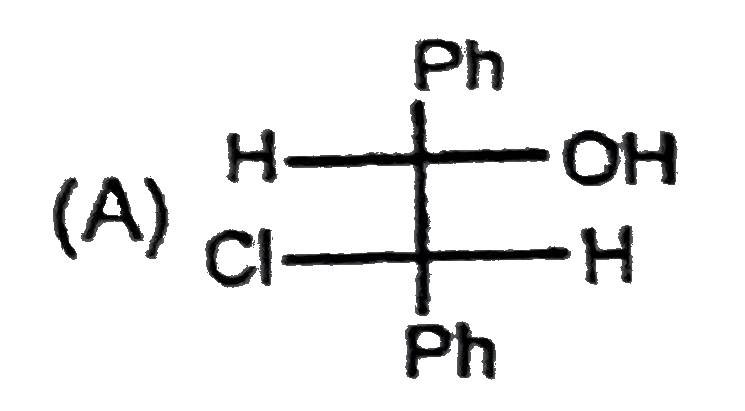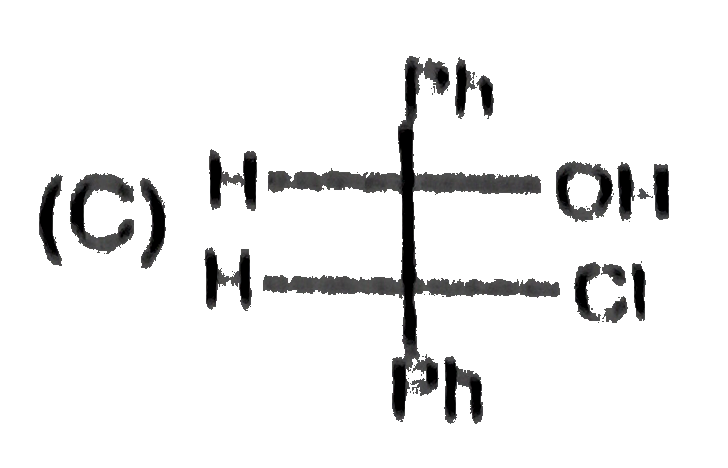Ph−C≡C−PhNa/NH3−−−−−→AHCCl/H+−−−−−−→B
The product B is



B and C both
The correct Answer is:D
To solve the given question, we will follow these steps:
Step 1: Identify the starting compound
The starting compound is Ph-C≡C-Ph, which is a symmetrical alkyne (1,2-diphenylacetylene).
Step 2: Perform Birch reduction
The first reaction involves the Birch reduction using sodium (Na) in liquid ammonia (NH₃). The Birch reduction of an alkyne results in the formation of a trans-alkene.
For our compound:
- The alkyne Ph-C≡C-Ph will be converted to trans-stilbene (trans-1,2-diphenylethylene).
- The structure of trans-stilbene can be represented as:
Ph-CH=CH-Ph, where the phenyl (Ph) groups are on opposite sides of the double bond.
Step 3: React with HOCl
The next step involves the reaction of the trans-alkene with HOCl (hypochlorous acid). The reaction of an alkene with HOCl leads to the formation of a halohydrin.
In this case:
- The trans-alkene will react with HOCl, where the chlorine (Cl) will add to one carbon of the double bond and a hydroxyl group (OH) will add to the other carbon.
- The addition occurs in a way that maintains the trans configuration, resulting in the formation of a 1,2-dichloro-1-phenylethanol.
Step 4: Identify the final product
The final product (B) after the reaction with HOCl will be:
- Ph-CH(Cl)-CH(OH)-Ph, where one carbon has a chlorine atom and the other has a hydroxyl group.
Final Answer
The product B is Ph-CH(Cl)-CH(OH)-Ph.
---
The starting compound is Ph-C≡C-Ph, which is a symmetrical alkyne (1,2-diphenylacetylene).
The first reaction involves the Birch reduction using sodium (Na) in liquid ammonia (NH₃). The Birch reduction of an alkyne results in the formation of a trans-alkene.
- The alkyne Ph-C≡C-Ph will be converted to trans-stilbene (trans-1,2-diphenylethylene).
- The structure of trans-stilbene can be represented as:
Ph-CH=CH-Ph, where the phenyl (Ph) groups are on opposite sides of the double bond.
The next step involves the reaction of the trans-alkene with HOCl (hypochlorous acid). The reaction of an alkene with HOCl leads to the formation of a halohydrin.
- The trans-alkene will react with HOCl, where the chlorine (Cl) will add to one carbon of the double bond and a hydroxyl group (OH) will add to the other carbon.
- The addition occurs in a way that maintains the trans configuration, resulting in the formation of a 1,2-dichloro-1-phenylethanol.
The final product (B) after the reaction with HOCl will be:
- Ph-CH(Cl)-CH(OH)-Ph, where one carbon has a chlorine atom and the other has a hydroxyl group.
The product B is Ph-CH(Cl)-CH(OH)-Ph.
Topper's Solved these Questions
Similar Questions
Knowledge Check
- Question 1 - Select One
In the reaction Me–C≡C−EtNa/lig.NH3−−−−−−−→PBr2−−→CCl4(Q), then Q is :
AA pure compound which is optically inactive due to internal compensationBA binary mixture which is optically inactive due to external compensationCA binary mixture which is optically activeDA pure compound which is optically inactive due to absence of chiral centre - Question 2 - Select One
Consider the following reaction,
H2C=CH−CH2CH2−OHBr2/CCl4−−−−−→ADil. KOH−−−−−→25∘CB
The product B is :A B
B C
C D
D
- Question 3 - Select One
Ph−O∣∣C−O∣∣C−PhH3CMgBr−−−−−→H⊕3O How many products will be obtained and how many can be separated by fractional distillation method?
A3,3B2,3C3,2D3,2
The compound C7H8 undergoes the following reactions :
C7H83Cl2/Δ−−−−→ABr2/Fe−−−−→BZn/HCl−−−−→C
The product 'C' isView SolutionPh−C≡ChB2H6−−−−−−−→H2O2/OH− Major Product is :
View SolutionIn the reaction
CH3COOHPCl5−−→(A)NH3−−→(B)NaBrO−−−→(C)
the final product (C) is:View SolutionThe product C of the reaction
CH3ClKCN−−→AH2O/H+−−−−−→BNH3−−→C isView SolutionPh−C≡C−CH3HgSO4−−−→H2SO4A,
View Solution
